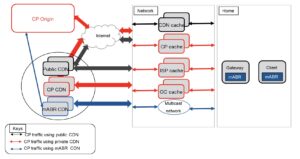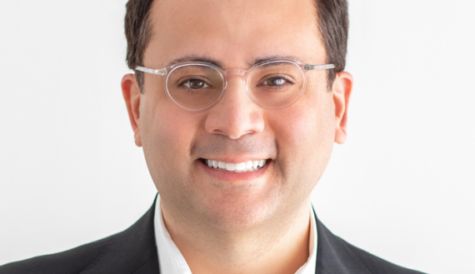Streaming: a new Multi CDN approach
The bandwidth demands of streaming mean that media companies are continuing to search for innovative CDN solutions. In this in-depth look at current trends in CDN technology, industry technologist Thierry Fautier assesses different approaches, including the concept of ‘diversity CDN’.
 With an ever-increasing demand for streaming, the video industry recognizes there is a need to provide more CDN capacity. We have seen the largest OTT streamers (YouTube, Netflix, Meta, etc.) all develop their own CDN infrastructure. For the rest of the market, we have seen a multi-CDN approach improve resilience, enhance Quality of Experience (QoE), and reduce costs. However, all these CDNs are facing the same challenge: the bottleneck that the ISP constitutes.
With an ever-increasing demand for streaming, the video industry recognizes there is a need to provide more CDN capacity. We have seen the largest OTT streamers (YouTube, Netflix, Meta, etc.) all develop their own CDN infrastructure. For the rest of the market, we have seen a multi-CDN approach improve resilience, enhance Quality of Experience (QoE), and reduce costs. However, all these CDNs are facing the same challenge: the bottleneck that the ISP constitutes.
There is a growing trend that started in recent years, involving the mixing of different CDN technologies, to achieve similar goals with proven performance.
‘Multi-CDN’ is a ‘horizontal’ approach, using more of the same technology and therefore achieving similar KPIs across the different CDNs selected on average. ‘Diversity CDN’, on the other hand, is a ‘vertical’ approach using different and complementary CDN technologies to achieve drastic performance improvements and drastic improvement in cost savings. This is a truly transformative approach.
Diversity CDN
An interesting aspect of the CDN story is how they have been moving towards greater scalability and how content providers (CPs) have been designing a multi-CDN technology approach. This trend started with Netflix, which deployed its own CDN inside the ISP network to improve performance and reduce costs. The Netflix Open Connect has inspired many of the CDN technologies discussed here. The first deployments started in 2012, but Netflix has never communicated on the performance of its own versus that of a public CDN. (For more details, see my recent blog published on this topic).
Map of CDNs
Let’s first build a chart of the different CDN technologies deployed by either CPs, ISPs, or CDN service providers.
Table 1 describes the exhaustive list of all CDN solution types deployed in the market.
| CDN Type | Model | CDN examples | Business model | Deployments examples | Device supported |
| Public CDN | Multi-tenant caching service | Akamai
Cloudfront Fastly Cloudflare Edgio |
Paid per traffic | All OTT services (except Netflix) | Any |
| CP CDN | Dedicated CDN for specific CP |
Netskrt
EBU broadcasters, TF1, SVT |
Paid per traffic | DAZN, Sky, EBU broadcasters, TF1 SVT | Any |
| On Net CDN | Reuse of private ISP CDN for OTT traffic | Synamedia | CAPEX model | TIM | TIM’s devices |
| ISP CDN | CDN service provided by ISP | Jio (Reliance)
SFR (Altice) Orange Group Telefónica Comcast Sky |
Paid per traffic | Jio
Any French CP Any Spanish CP Any US CP Any UK/IT CP |
Any |
| OC CDN | Multi-tenant caching service | Qwilt | Paid per traffic | Disney+
Various ISPs (e.g. BT, TIM) |
Any |
| mABR CDN | Multicast assisted CDN | Broadpeak | CAPEX | TIM
Orange |
TIM/Orange set-top boxes |
Table 1: CDN map
Public CDN: Deployed by all CPs, using multi-CDN.
CP CDN: A dedicated CDN for a particular CP (e.g., Netflix), behaving like a public CDN but with charges per traffic. Located mostly inside the ISP network, providing better performance compared to a public CDN as content is fetched without peering point throttling.
On Net CDN: Operated by a vendor (e.g. Synamedia) for an ISP’s IPTV service, with caches reused for OTT traffic. Provides better performance as content is fetched without peering point throttling.
ISP CDN: Operated by the ISP (e.g. Comcast) with caches entirely located inside the ISP network. Provides better performance as content is fetched without peering point throttling.
Open Caching (OC) CDN: Operated by a vendor (e.g., Qwilt), cooperating with both CPs and ISPs. Caches are entirely located inside the ISP network, providing optimal performance. Specified by SVTA, enabling a multi-tenant approach where edge caches could be shared by several CPs. Provides better performance as content is fetched without peering point throttling.
mABR CDN: Operated by a vendor (e.g., Broadpeak), cooperating with ISPs. Live content is ingested to the ISP’s network in Unicast, then transformed by mABR CDN into a Multicast carousel. The ISP set-top or gateway picks the Multicast traffic and feeds the end device with Unicast traffic. Provides better performance due to Multicast attributes with higher bitrates available at all times and minimum delay. This solution also offers a guaranteed bandwidth vs other Unicast CDN solutions. Standardized by DVB, although proprietary implementations also exist.
Architecture
We describe in figure 1 the different technical solutions a Content Provider (CP) / ISP can deploy.

Figure 1: CDN map network
From a workflow perspective, the Origin is controlled by the CP and connects with different type of CDNs:
- Public CDN
- The private CDN deployed by the CP, that can use different technologies: classical HTTP caching or Open Caching
- The ISP CDN
- The mABR CDN deployed by the mABR CDN operator
Performance aspects
We will provide in Table 2 performance numbers made available by CDN companies and measured in real deployments, compared to public CDNs that are taken as a reference. Note that for each case, different public CDNs were used. as a reference and with different networks also.
CDN |
Broadpeak | Qwilt | |
| Type | mABR | Open Caching | |
| Metric | |||
| VSF-T | Video start failure reduction | 89% | 63% |
| CIRR | Buffering measurement reduction | 76% | 54% |
| VPF-T | Failure inside the session reduction | 86% | 48% |
| AVG P | Average Peak rate improvement | 11% | 7% |
Table 2: Diversity CDN performances
(*) VST: Video Start Time
From this analysis, it appears that Edge caching deployed inside ISPs, here with an Open Caching flavour, provides an overall similar performance that is indeed very close to the results provided by mABR.
We expect to get over time more results available from other CDN solutions (CP, CDN, On Net CDN, ISP CDN) and therefore compare the mutual performances.
Conclusion
Looking ahead, this Diversity CDN Technology approach will introduce more complexity for CPs, as they have to manage different technologies, and for ISPs, as they must host more caches in their network. However, the reward is the possibility for new CDN companies to enter the CDN market delivering better performance and lower costs.
One way for ISPs to reduce their costs is to utilize their Multi-access Edge Computing (MEC) infrastructure or employ a local public cloud instance in their network. This would provide a cloud-native caching infrastructure capable of handling the elasticity of traffic. The benefit of such an approach is having a more scalable solution to deploy and the ability to reuse caching servers when capacity is not needed, making it more economical and environmentally friendly.
Thierry Fautier is managing director of Your Media Transformation



